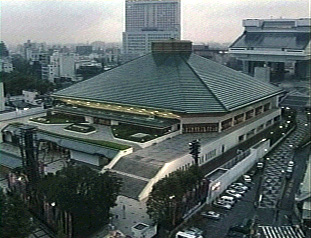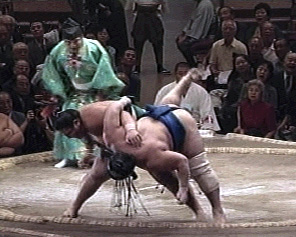Japan Stories: September
Our First Month
We took hardly any photographs in September (after a day or two, we decided we couldn't lug a camera everywhere we go for a whole year), but here are some highlights from our first full month in Japan.
In search of the perfect apartment
We spend a good chunk of September looking for a suitable home base in Japan. We don't have many demands, but they are sufficient to cause our search to run longer than expected. We are looking for a place that is modest-sized by American standards, which means it needs to be enormous by Japanese standards. In particular, we would like an extra bedroom or two we can convert into offices for the two of us. We also want to live in a neighborhood where we can walk to good restaurants and interesting shops. Lastly, we are hoping to live in a building with Japanese neighbors, instead of being confined to a gaijin ghetto.
We are stunned by some of the differences between renting an apartment in the U.S. and renting in Japan. In the U.S., rental apartments typically:
- Include ceiling lights as a standard feature
- Include window blinds or some other cheap window covering as a standard feature
- Include appliances such as a refrigerator
- Can be rented by anyone who's money is the right color
- Are paid for one month at a time.
In Japan, on the other hand, rental apartments:
- Do not include ceiling lights as a standard feature. (If they are included, the real estate agent makes a special effort to point them out. "Look, this one comes with lights!")
- Do not come with curtains or window blinds, despite the fact that many apartments do not have the same size windows
- May come with a pre-installed ISDN high speed Internet connection, but may not come with refrigerator
- Can only be rented if a reputable company vouches for your character (in lieu of a reputable company, one may substitute a reputable Japanese citizen)
- Can be put on hold for a couple of days if you want to think about it
- May require an enormous amount of rent (often six month's worth) up front.
We concentrate our apartment hunting in a Tokyo's Daikanyama neighborhood, a trendy—nay, tony— district on the edge of downtown. The first place we look at in Daikanyama is great in every detail save that it sits across the street from a massive construction site. How long is the construction going to continue? "Two years," our real estate agent admits sheepishly. To be fair, Japanese construction sites are unbelievably peaceful and quiet places compared to American construction sites. Nevertheless, we are afraid the construction might spoil our opportunities for the occasional afternoon nap. We continue searching.
We see a few more places in the neighborhood, but nothing remarkable. Just as we are losing hope, we find the perfect apartment. Right size, nice interior, spare rooms for offices, located on the top (third) floor of a building so it gets lots of light, and a short walking distance to tons of restaurants and shops. We are crushed to hear another couple has just put the apartment on hold; we missed our chance by about two hours. There's another apartment for rent in the same building, but it's on the first floor, and a little too big, and a little too dark, and our hearts are set on the third floor apartment. We spend a nail-biting weekend hoping the couple with the apartment on hold will find somewhere else they like better, but they decide to take the perfect apartment for themselves. We continue searching.
Conducting an important phone call in four poorly-understood languages
To rent an apartment in Japan, a foreigner needs to have a guarantor—a person who will vouch for them. This is similar to having someone co-sign a loan in the States. Jan is puzzled about how we go about finding such a person, but Angela explains this will be done the Asian way: family connections.
Angela's uncle uncovers some distant family relatives living in Japan, including a doctor named Sugiyama who lives in Gifu City, several hours south of Tokyo. As far as we can determine, Dr. Sugiyama is Angela's dad's cousin, which is to say, Angela's cousin once removed. He was born in Taiwan, but he's been living in Japan for the past thirty years or so. Angela's uncle has gotten in touch with Dr. Sugiyama, and Sugiyama has agreed to act as our guarantor while we are in Japan.
Now that we've arrived in Japan, we want to call Dr. Sugiyama on the phone and let him know that we're here and (if all goes well) will soon need him to sign some documents as our guarantor. For us, it's vital that we not only make a good impression on him, but that we also communicate exactly what we'll need him to do. We've heard that he doesn't speak English, so the phone call might be a little tricky.
One evening, after dinner, after we've psyched ourselves up for the task, Jan places the call. He begins the phone call in Japanese, but once Dr. Sugiyama is on the phone, Jan realizes his Japanese might not be up to the task. Talking on the phone is always harder than talking in person, since you can't hear each other as well, can't watch the other person's mouth to help figure out what they're saying, can't use hand gestures to clarify a point, and can't let the other person see your befuddled facial expressions when you're confused. Jan hands the phone to Angela, so that she can speak to Sugiyama using her passable Mandarin.
Angela and Dr. Sugiyama talk for a minute in Mandarin, but Sugiyama says it's been a very long time since he's spoken Mandarin, so would Angela mind if they speak in Taiwanese? Angela agrees to give it a try. Her Taiwanese isn't as good as her Mandarin, though, and she has trouble making herself understood.
Dr. Sugiyama decides that maybe his daughter, Emi, should get on the phone, since Emi spent ten months in Australia seven years ago and knows some English. Emi's English is a little rusty. Angela figures it's better if Emi talks with Jan, so Angela hands the phone back to Jan. Emi discovers that Jan speaks Japanese, and since Jan's Japanese is better than her English, they switch to Japanese. Emi announces to her father, "Hey, he speaks Japanese!", so she hands the phone back to her dad. And now Jan and Dr. Sugiyama are talking to each other again in Japanese, exactly the same way the phone call began.
We eventually muddle through and (we hope) explain who we are and why we're calling. We get off the phone and collapse, exhausted, on the bed. Our heads hurt. Before we are done with this year, we will have to make many, many more phone calls just like this.
The elderly get no respect
In Japan, September 15th is a holiday called keiro no hi, or "Respect for the Elderly Day." Since it's a national holiday, everything closes. Days before the event, different business announce how they will "respect the elderly." On the Monday before the holiday, the Japan Times, a local Tokyo paper, runs an article announcing that Japanese tobacco companies, as a gesture of respect, will give a free pack of cigarettes to anyone over 65 years of age.
Complete idiots
Walking through Tokyo's Kinokuniya bookstore, Jan spots an American book titled, "The Complete Idiot's Guide to Millennial Predictions." The publishers of this book apparently see no irony in this title.
Large men in small loincloths
We happen to be in Tokyo during the annual fall sumo tournament. Our friends James and Maggie have tickets to one of the tournament days and, luckily for us, invite us along. The tournament day starts at 2:00 pm and should be over at 7:00 pm. That's a long day, but a day of sumo really is quite an event.

Tokyo's Kokugikan sumo stadium (photo by someone else)
Most people don't actually show up until a little before 4:00 pm. That's because the day starts with the most inexperienced sumo wrestlers, not to mention the most inexperienced referees and judges. As the day progresses, the skill level of the participants increases until, at the very end of the day, the champion sumo wrestlers compete.
Despite the long day, each bout is actually rather short—no more than a few minutes. Some are even over in a half second. Each sumo wrestler has only one bout during the day. However, he may take a while to get started—there's a lot of entering and exiting of the ring with a lot of salt-throwing (a Shinto purification ritual). This means that, like baseball, there is lots of "down" time to chat with friends, eat food (more on this later), and generally just hang out. Unlike baseball, or even football, it's pretty obvious when one is supposed to pay attention, so it's hard to miss the action.

Throwing their weight around (photo by someone else)
Rather than go to the earlier bouts, we decide to join our friends at the sumo stadium, called the Kokugikan, around 3:30 pm. We show our tickets at the gate and are told to go to "number 12." What this means is we are to enter the same door as everyone else, and fight our way through the crowd to the number 12 concession stall inside the building. There, we show our ticket stub to a man dressed in a cotton kimono.
He asks us what we want to drink, grabs the bottles of soda, and proceeds to lead us to our "seats." He points us to a 5' x 5' section of the floor. The section is bounded by low metal bars. In the section wait our friends and bags of food as big as our friends are. We kid you not—the bags contain food on sticks, food in boxes, food in boxes within boxes, food in plastic bags, food in paper bags, finger food, chopsticks food, fork food, seafood, and questionable "food." It is rather hard to fit the four of us into this floor section with all this food, and in a battle between us and the food over space, the food eventually wins. How do you know that the food won? Well, after the sumo matches, everyone is given a huge shopping bag full of what we think will be cool sumo presents. What do we find instead? Food!
We're stuffed, but manage to scarf down half a box of chocolate sumo wrestlers anyway.
In search of the perfect apartment, part two
We keep hoping for another perfect apartment, but our real estate agent, Hohnoki-san, eventually tells us that we've seen every available apartment that meets our criteria in the neighborhood. He shows us an apartment in the nearby Ebisu district, and while the apartment does seem nice, we're disappointed we can't find a place in a neighborhood we really like.
Angela realizes that our apartment's location is perhaps more important to us than we had originally thought, maybe more important than the apartment's interior. After all, we can do things to improve the look of an apartment on the inside, but we can't change the surrounding neighborhood outside.
We go back and look at the apartment on the first floor of the building with the perfect third floor apartment. We had passed this apartment over earlier, because it hadn't been as perfect as the one on the third floor. As soon as we walk in, we realize we've been stupid. "What were we thinking?!?" we ask ourselves. The apartment on the first floor is fine. More than fine, in fact—it's great. We tell our agent our search is over: we'll take this one.
Real-estate Catch-22
There are still, however, some details to work out before we can have the place. For starters, we have to pay a whopping eight months rent for the apartment we want. The rent must be paid by a domestic bank transfer (i.e., from one Japanese bank account to another), so we need to open a local bank account first. We inquire at a couple of banks about opening an account, and it turns out that we need to first obtain an alien registration card. Any foreigner living in Japan can apply for this type of card at the local city ward office—as long as they have a place to live. This last requirement completes a nice, tight circle of successively dependent conditions: a Catch-22.
To help us unwind the bureaucratic tangle, our friend James agrees to launder our initial rent payment through his own Japanese bank account. This lets us proceed with the apartment application, which lets us apply for an alien registration card, which lets us get a Japanese bank account, which lets us pay the rest of our rent.
We choose to open an account at the local branch of Sakura Bank, an arm of the giant Mitsui conglomerate. We pick Sakura partly because their branch is very close to our apartment, but mostly because they have the cutest cartoon mascot.

Doraemon: the wacky atomic-powered cat from the 22nd century, and
official Sakura Bank mascot